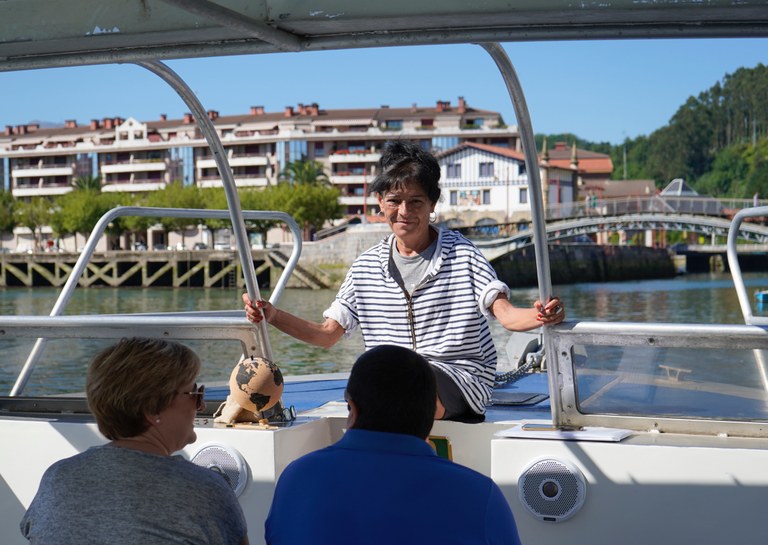Violeta Bandrés: "Historically, for centuries, Zumaia dominated the naval industry"
Violeta Bandrés is a guide for visitors and students. Conducting guided tours in the Urola Kosta region, at the Geopark and, especially, in Zumaia, if anyone is aware of the importance and significance of Zumaia's maritime heritage throughout history, it is she.
As soon as we arrive in Zumaia we become aware of Zumaia's connection to the sea.
Zumaia's location is ideal, at the mouth of the Urola River, and that says it all. The first thing you see when you arrive on the highway is the Balenciaga shipyard. Although today it may have a bleak future, it remains the last vestige.
What peculiarities has the Basque Country had, and which does it still have?
Ours is a small land, and a mountainous one. Today it is easy to reach the coastal villages because the roads are of high quality and we have both public and private transport. But that's a relatively new development, over the last 100 or 150 years. Our landscape is very beautiful, but, over the course of history, it has also been a limitation, so one of the only opportunities people had was to turn to the sea. Business was related to the sea. In this way, the sea has been the source of our livelihoods.
The main manifestation of this is the shipbuilding industry, which has been vital to the town; at one point the Port of Zumaia was one of the most important, in terms of shipbuilding.
Yes, and there are numerous references to it. Here, in Zumaia, its golden age was, especially, in the 15th and 16th centuries. There were up to eleven shipyards along the banks of the Urola. Although, by today’s standards, these shipyards were simple, some featuring wooden structures, the Basque Country’s shipyards boasted the most advanced and developed technology in all of Europe. And Zumaia was one of the most important areas. It had a special location, in the estuary, shielded from the sea, and close to raw materials of high quality: indigenous oak, as well as beech, iron from Urola Garaia... Many of the ships, including naos, and others, were built here. Historically, Zumaia dominated the shipbuilding industry, for centuries.
The impact of those high-quality raw materials and products was reflected in Elkano's trip around the world, right?
That's an understatement, I would say; five ships went out on that expedition, and three of those five were manufactured at area shipyards. The fact that three of the vessels on such a "macro expedition" were local says a lot. At the time of "Race to the Indies," when Europeans began their expeditions, 80% of the ships were Basque. And the research clearly shows that. Therefore, it is evident how important the shipyards have been to us.
Some guided tours that can be taken in Zumaia allow one to learn more facts about Elkano's voyage around the world. But Zumaia features many more curiosities, such as the stories of the Battle of Gibraltar on the votive tablet of the sailor Juan Martínez de Mendaro in the Parish Church of San Pedro.
This shows that, in addition to the shipyards, sailors were also of great importance. In addition to paintings about sailors, we also have triptychs brought from Europe, such as the Flemish triptychs from the early 16th century by the Sasiola and Elorriaga families, true art works that can be admired in the side chapels of the San Pedro parish church. What does that mean? Expeditions were made by those ships that were produced at the shipyards here, but many other ships were dedicated to trade, so we were the bridge between the Mediterranean, Castilian and Atlantic economies. We were the shippers, such that we had close ties to Northern Europe. Works of art, among other items, were brought from these places, the most representative piece being the votive panel made in honor of the sailor Juan Martínez de Mendaro, which depicts the Battle of Gibraltar. After all, we have been fishermen, shipyard workers, merchants, and naval mariners, the sea being what unites all of these.
Neither can we forget Itzurun Beach, the Flysch and, in general, the Geopark, although they are more related to geology than to the sea.
Without any doubt. Today, in the 21st century, the Geopark on the Basque Coast is a globally renowned area. We have one of the most important geological heritages, and it is a leader in research, for its landscape... The Flysch constitutes a geological phenomenon in which we can read the history of the Earth, learn about its past, better understand it at present, and see into the future. Knowing where we come from and where we are going is vitally important, and geology, and the Flysch, give us that opportunity.

 turismoa@zumaia.eus
turismoa@zumaia.eus
 Bulegoa
Bulegoa











